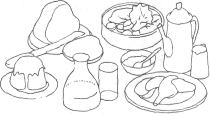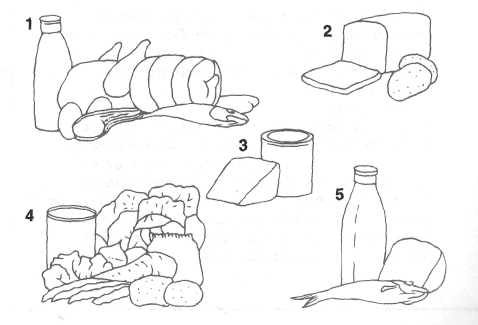Пособие по обучению практике устной и письменной речи (начальный этап) на английском языке Под ред. О. В. Серкиной
 Скачать 17.03 Mb. Скачать 17.03 Mb.
|
|
Britain and good food are two things which are not commonly associated. Visitors to Britain have widely varying opinions about all sorts of aspects of the country, but most of them seem to agree that the food is terrible. Why? One reason could simply be that British tastes are different from everybody else’s. However, the most common complaint is not so much that British food has a strange, unpleasant taste, but rather that it has very little taste at all. The vegetables, for example, are overcooked, to put it mildly. Another explanation may be that most visitors to Britain do not get the opportunity to sample home cooking. They either еat the food cooked in an institution, such as a university canteen, or they eat out a lot, usually in rather cheap restaurants and cafés. These places are definitely not where to find good British food. Typical British cooking, which involves a lot of roasting, does not suit the larger scale production or the quick preparation which is required in such places. For one thing, food should, according tо British people, be eaten hot, which is difficult to arrange when feeding large numbers of people. In addition, the British have not got into the habit of preparing sauces with grilled food in order to make it tastier. The explanations above can only serve as a partial excuse for the unfortunate reputation of British cuisine. Even in fast food restaurants and everyday cafés, the quality seems to be lower than it is in similar places in other countries. It seems that British people simply don’t care enough tо bother. The country has neither a widespread “restaurant culture”, nor a café society. In the middle of the day, people just want to eat up quickly and are not interested much in quality (the lunch break is an hour at most). Young people and families with children who eat at fast food places are similarly not interested in quality. Little effort is made to make the hamburgers tasty because nobody expects them to be. The coffee is horrible not because British people prefer it that way but because they don’t go to a café for a delicious, slow cup of coffee - they go there because they need the caffeine. Even at home, food and drink is given relatively little attention. The coffee is often just as bad as it is in the cafés. British supermarkets sell far more instant coffee than what a few people who drink it often call “real” coffee. Instant coffee is less trouble. Meals tend to be eaten quickly and the table cleared. Parties and celebrations are not normally centred around food. For example, if a British person expresses a liking for barbecues, this does not necessarily mean that he or she likes barbecued food - it is understood to mean that he or she enjoys the typical barbecue atmosphere. When the British do pay attention to food, it is most frequently not tо appreciate it but to notice what they don’t like about it. Food hits the headlines only in the context of its dangers: for example when a government minister announced that the country's eggs were infected with salmonella. In the early 1990, everybody in the country knew about “mad cow disease” (= a disease affecting the brains of infected cattle). There are quite a large number of vegetarians in Britain and an even larger number of those who are aware of the implications for their health of what they eat. “Health food shops” are as abundant in the country’s high streets as delicatessens. British people have been mostly urban, having little contact with “the land'” for longer than the people of other countries. Perhaps this is why the range of plants and animals, which they will eat is rather narrow. To most people, the idea of going out to pick wild plants for the table is exotic. It is perhaps significant that when the British want to refer to the people of another country insultingly, they often allude to their eating habits. Because of the strange things they do with cabbage, for example, the Germans are “krauts”. Because of their outrageous taste for frog legs, the French are “frogs”. However, the picture is not entirely negative. While the British are conservative about ingredients, they are no longer conservative about the way they are served. In the 1960s, it was reported that the first British package tourists in Spain not only insisted on eating traditionally British fish and chips all the time but also on having them, as was traditional, wrapped up in specially imported British newspapers! By now, however, the British are extremely open to the cuisine of other countries. The country’s supermarket shelves are full of the spices and sauces needed for cooking dishes from all over the world. The increasingly multicultural nature of the population has helped in this respect. In addition, there is increasing interest in the pure enjoyment of eating and drinking. 1.20. Manners to behave in restaurants and at dinner table vary widely from country to country. Discuss these questions with a partner or in a small group.
Long readings sometimes need headings to help focus the reader! Practice finding the most suitable heading for the parts of the text below. 1.21. a) As you read this selection, match each passage to the heading below. b) Take notes from the text about table manners. Then fill in the chart that follows for all the countries mentioned in the text. ___ Leaving Food or Not ___ Eating Internationally ___ Observing Carefully ___ Serving Something to Drink ___ Using Tableware ___ Keeping Your Hands in the Right Place ___ Using a Toothpick ___ Cleaning Hands All Manner of Manners [1] The Parker Pen Company has been doing business internationally since 1902. In that time, the company has collected many reports about customs in different countries. In 1985, Parker Pen asked Roger Axtell, one of its international sales representatives, to collect these reports in a book about cultural differences. The result is a series of books called Do’s and Taboos Around the World. [2] The books deal with all sorts of customs, but the information about eating gives an idea of the challenges an international traveler faces. Customs for dining with guests vary so much from one country to another that you could do something polite in one country that has a completely different meaning in another. Here is one classic example: a host in the United States offers a guest from Jordan more food at dinner. The guest refuses and the host does not offer again. The Jordanian may be shocked and hungry because in Jordan, it is polite for the host to offer the food several times while it is polite for guests to refuse, even if they want more. Then what happens when someone from Jordan travels to Zambia? There, according to Axtell, it is impolite for the host to offer food first. If you aren’t aware of this custom, you may all be hungry! [3] In some countries, guests are expected to finish everything on their dinner plates. In other countries, such as Egypt, it is polite to leave something. In China, the host will continue to fill a guest’s dish. It is polite to leave some food in the dish in order to show how generous the host was. At a formal dinner, the second-to-last course is sometimes plain boiled rice. You should refuse this to show that you are satisfied and full. [4] What about serving yourself more to drink? In many Asian countries, you can fill everyone else’s glasses, but not your own. You will have to wait for someone else to offer you more to drink. However, if you are a woman in Italy, don’t pour your neighbor a glass. Some people do not consider this appropriate behavior for a woman. If you do pour the wine, think twice about which hand you use. In Bolivia and Chile, most people consider it incorrect to pour the wine with your left hand. When someone pours you something to drink, do you hold your glass up or leave it on the table? Customs for this are different in many countries. [5] In the United States, you are supposed to keep one hand in your lap while you’re eating. It is considered impolite to put your elbows on the table. Diners usually hold a knife and fork only when they are cutting something, and then they put the knife down to change hands and eat with the fork in their right hand. If food is fairly soft, they use the side of the fork to cut it. However, in many countries, just the opposite is often true. People eat with their wrists resting on the edge of the table and continue to hold both the knife and the fork in their hands while they eat. In Brazil, it is considered rude to cut food with the side of a fork. [6] According to Axtell, if you want more food in Spain, you should put your knife and fork down on opposite sides of the plate. In Greece, to show that you are finished, cross your knife and fork on the plate with the fork facing up underneath. In Argentina, do the same thing, but put the fork face down. In other countries, you position your knife and fork close together on the side of the plate or diagonally when you are finished. [7] Of course, in many countries people don’t eat with knives and forks. They may eat with their hands, but in most countries only with the right hand. The left hand is considered unclean. If people use chopsticks, it is common to pick up the dish and hold it close to your mouth. But how close should you hold it? Customs vary from country to country! [8] In some countries, cleaning your hands is part of the mealtime experience. In Morocco, someone will bring a pitcher of water and a basin before you eat. You hold your hands over the basin and rinse your hands in the water that is poured from the pitcher. In Japan, you will get a warm, wet cloth to wipe your hands before you eat. In other countries, such as Italy, cleaning your hands after youeat is important. You may have a finger bowl beside your plate to rinse your fingers in. [9] When you have finished eating, can you use a toothpick? In the United States, it is impolite to use a toothpick in public. In other countries, using a toothpick shows that the food was delicious. But be careful how to use the toothpick! In some countries, it is polite to hide the toothpick behind your hand. [10] So what is a traveler to do? Axtell recommends that you watch others carefully to see what they do. He also says that conversations about customs are very interesting, so ask questions about ways to do things. He ends each of his books by talking about the universal action that can help a traveler in many situations – the smile.
1.22. Do the following questionnaire. How do you feel about food? Discuss your choices a partner, then in class. Health Quiz 1. Which of these would you eat? a. frog’s legs b. horse steak c. caviar d. snails e. blood pudding f. sheep’s eyes g. brain 2. Which of these do you think is luxury food? a. oysters b. lobster c. truffles d. pheasant 3. Which of these do you eat most of? a. potatoes b. rice c. pasta d. beans 4. How many meals do you eat every day? a. two b. three c. four d. five 5. Which of these do you like eating best? a. French food b. Chinese food c. Indian food d. Italian food e. home cooking 6. How often do you eat out? a. every day b. once or twice a week c. several times a month d. occasionally e. seldom f. never 7. If you have ever tried to slim, did you …
8. Do you think you eat … a. a little? b. enough? c. quite a lot? d. definitely too much? 1.23. a) What does our food consist of? What elements are vital for human bodies? Read the passage below and discuss your menu with a partner. Nutrients in food Foods give us proteins, carbohydrates, fats, vitamins, and minerals.
b) Study the daily food intake for the Western and non-Western worlds. How is the consumption different? Which type do Russians belong to? Food intake T  he diagrams compare average daily calorie consumption of different foods per person in two regions. In the Western world people eat more food of more kinds than they do in the non-Western world. he diagrams compare average daily calorie consumption of different foods per person in two regions. In the Western world people eat more food of more kinds than they do in the non-Western world.American-European food consumption Breakfast cereals, milk, sugar, juice, coffee, 1 Snacks tea, coffee, milk, sugar, cookies  400 calories 400 caloriesLunch soup, main dish, salad, bread, 1  ,000 calories butter, dessert, coffee, milk, sugar, wine, or beer ,000 calories butter, dessert, coffee, milk, sugar, wine, or beerDinner main dish, salad, bread, 1,100 calories butter, dessert, coffee, sugar, milk, wine, or beer Total: 3,500 calories average daily intake A  sian-African food consumption sian-African food consumptionBreakfast, rice, milk, pulses (= beans), lunch, and vegetables, very little meat dinner or fish Total: 2,000 calories average daily intake c) Have you ever heard about the food pyramid? What is it? Work in a small group and complete the chart below. Do you agree with such a distribution of food consumption? Discuss it in class.  Food at the top of the pyramid - fats, oils, and sweets should be eaten only sparingly. People need protein in moderate amounts in their diets, so the upper middle section of the pyramid contains two groups of food that supply protein: milk, yogurt, and cheese; and meat, poultry, fish, dried beans, eggs and nuts. Nutritionists recommend that people eat two to three servings of these foods a day. Most people need to eat more fruit and vegetables, represented in the two lower middle sections of the pyramid. People should eat three to five servings of vegetables and two to four servings of fruit a day. The base of Food at the top of the pyramid - fats, oils, and sweets should be eaten only sparingly. People need protein in moderate amounts in their diets, so the upper middle section of the pyramid contains two groups of food that supply protein: milk, yogurt, and cheese; and meat, poultry, fish, dried beans, eggs and nuts. Nutritionists recommend that people eat two to three servings of these foods a day. Most people need to eat more fruit and vegetables, represented in the two lower middle sections of the pyramid. People should eat three to five servings of vegetables and two to four servings of fruit a day. The base ofthe pyramid consists of grains, the food group that should be eaten the most (six to eleven servings a day), including bread, cereals, rice, and pasta. 1.24. More people try to follow a balanced diet nowadays. a) Read the text about cholesterol and health. b) Answer the questions and add up your scores to see if you have a balanced diet. c) Discuss with a partner what you could change in your diet to make it more balanced. |

 Carbohydrates provide energy for rapid use. They include sugars in fruits, sugar cane, and sugar beet; starches in potatoes, bread, cereals such as wheat, rice, maize, oats, and barley, and vegetables.
Carbohydrates provide energy for rapid use. They include sugars in fruits, sugar cane, and sugar beet; starches in potatoes, bread, cereals such as wheat, rice, maize, oats, and barley, and vegetables.